The most straightforward way of improving the accuracy of water quality simulations is to reduce the quality time step. However, with large models, this increase in temporal resolution will eventually make the simulation run for too long. InfoWater Pro's new adaptive mixing resolution feature directly increases the accuracy of simulations, especially in models with rapid changes in quality values. By itself, the feature will make simulations slower but, by altering other parameters, it can help accelerate runs considerably. This page will show you how to use the new adaptive mixing resolution feature to balance the performance and accuracy of your quality simulations.
What is adaptive mixing?
Traditionally, water quality engines perform all calculations at the same temporal resolution. These include chemical reactions, transport through pipes, mixing at junctions, and release. Assuming a moderate temporal resolution for a model, this scheme is adequate for simulating the impact of events that occur at coarse or moderate time scales, like with increases in demand throughout the day. However, many events can occur at much finer scales, like when a pump is turned on, or a chemical injection is triggered. Imagine that a pipe has clean water followed by a front of pollution. The traditional approach would mix all water parcels, polluted or not, throughout the length of the step, and then convey them downstream as a single homogeneous combined parcel. The effect of this is a loss of fidelity in the quality time series observed downstream. That is, contamination events with sudden peaks and valleys might end up looking much smoother and with milder peaks.
Consider the following trace simulation results for EPANET's Net3 model, one using a quality time step of 60 minutes (blue) and another using a step of 1 minute (green). When using the coarser resolution, there is a considerable delay in the arrival of the water parcels coming from the Lake and the River reservoirs. This is a direct consequence of bulk-mixing parcels together throughout the network.
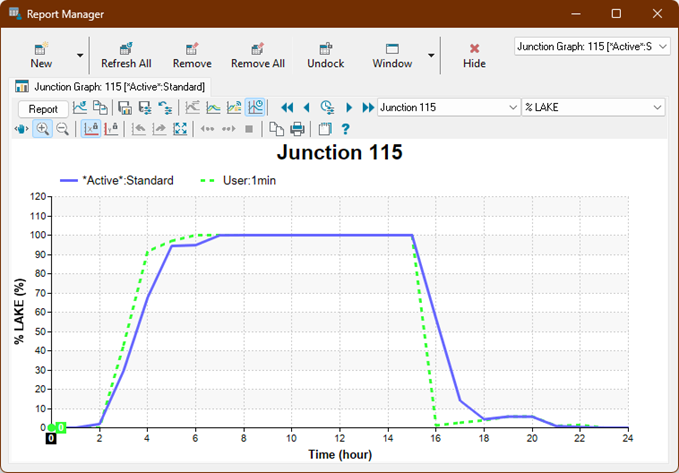
Adaptive mixing is an optional scheme for modeling water quality, released in InfoWater Pro 2025.0. It simply decouples the temporal resolution of the mixing and release computations from that of the chemical reactions. Instead of mixing all the parcels that arrive at each junction during the defined time step, and releasing them as one, the upstream heterogeneity is maintained in the downstream response. That is, if a pipe is carrying a chemical plume with concentration variations, those variations are conveyed downstream instead of flattened away. Mixing and release are thus performed in synch with parcels arriving at junctions, increasing the resolution only when necessary. In this way, accuracy is increased in some parts of the network, whereas the standard resolution is maintained in others where concentrations are not changing significantly.
Boosting accuracy in small and medium models
Follow these steps to increase the accuracy of simulations in models with short quality run times:
- Activate the adaptive mixing option. The option is found in
Simulation Options > Quality tab.
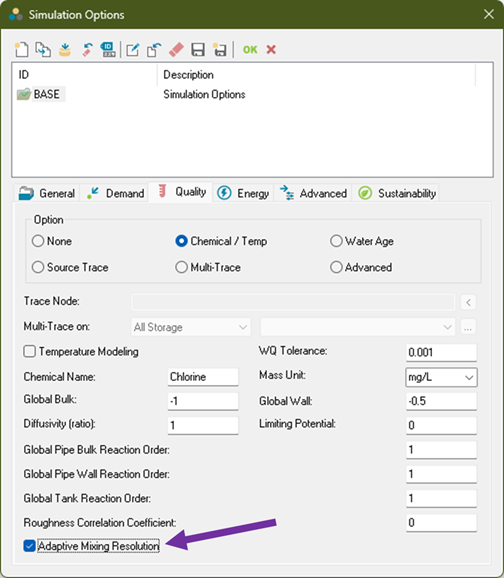
- Run the simulation.
- Assess if the running time is acceptable. If the quality simulation became too slow, please follow the steps for large models below.
For models that do not have long quality simulation times, simply activating the adaptive mixing option will result in more accurate results. This occurs because of a finer level of detail in the mixing of water parcels.
Accelerating quality simulations in large models
Follow these steps to improve the run time of slow water quality simulations without sacrificing result accuracy:
- Establish model benchmark elements. Determine one or more elements in the network for which the results are critical. For example, a representative junction in an edge district with high water age.
- Establish desired accuracy. Without activating the adaptive mixing option, run the simulation with different quality steps until a desired level of accuracy is reached. This can be achieved by progressively reducing the quality step until further reductions do not significantly affect the resulting quality time series at the benchmark elements (and only make the simulation run longer).
- Save desired results. With the selected quality step, store the simulation results with the option in the Run Manager.
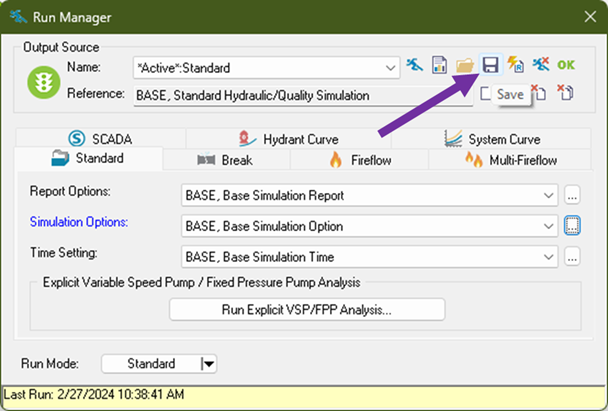
- Default to base quality step. Select a long quality step, e.g., like the hydraulic step.
- Activate the adaptive mixing option. The option is found in Simulation Options > Quality tab.
- Increase the quality tolerance. As a starting point, we recommend a value five times as high as the one used normally. This parameter is also found in the same dialog.
Note: The tolerance is in the same units as the quality values, and it should be scaled to match their variation range. As a rule of thumb, it is safe to use a thousandth of the normal variation range of your quality value as the tolerance. For example, simulations with chlorine concentrations between 0 and 2 mg/L can use a tolerance of 0.002; water age ages between 0 and 48 hours could use a value of 0.05; and tracer ranges between 0 and 100 can use a value of 0.1.
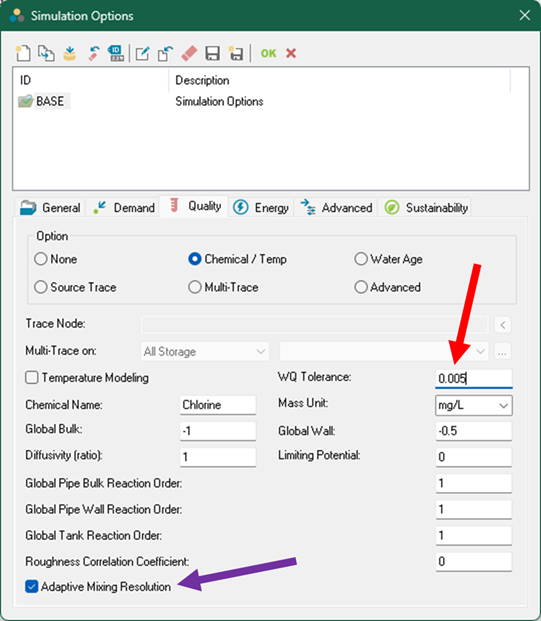
- Run the simulation.
- Compare the results with the desired ones. The desired results should be loaded into the project. To compare time series graphs, for example, first click on the Reference Graph button on the Report Manager graph tab. Then, on the Reference Graph dialog, click on a) "XXXX" Reference Sources, b) Data from Other Output Source(s), c) Select…, d) User:YYYY (saved desired output), e) OK, and f) OK.
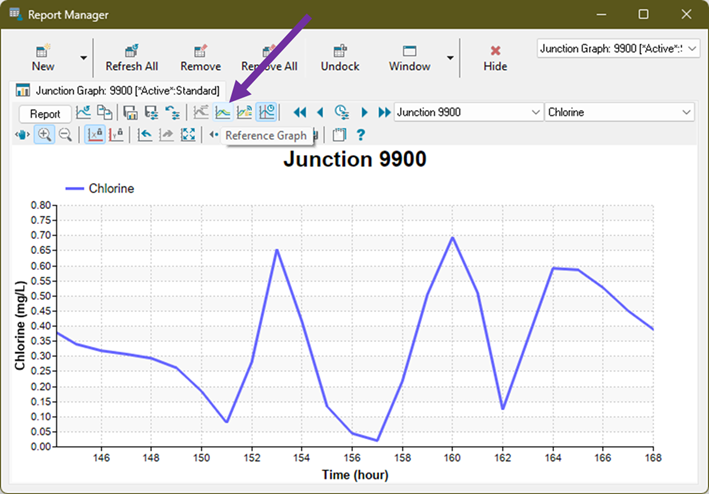
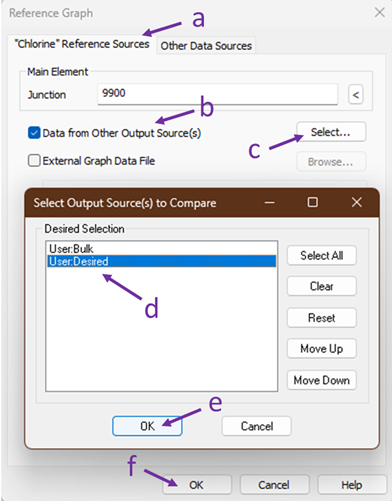
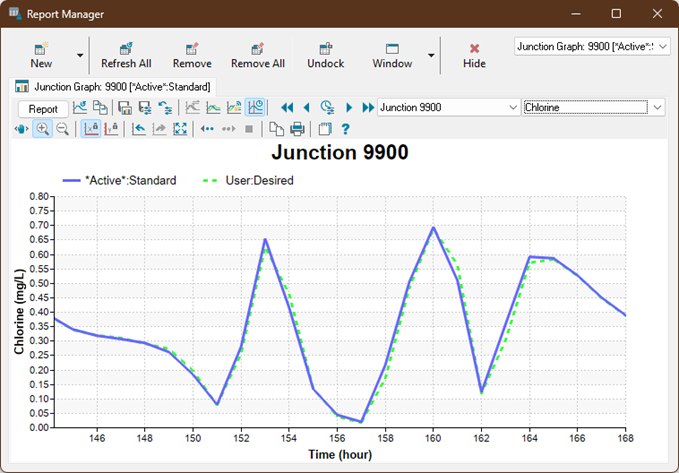
- Fine tune tolerance. Further increasing the tolerance will result in faster simulations; decreasing it will result in more accurate ones. Re-adjust the tolerance, re-run the simulation, and refresh the comparisons to further explore the trade-offs between performance and accuracy.
Ideally, this process will result in overall better performance with similar or better results than before. However, adaptive mixing will be more beneficial if there are significant heterogeneities in the model. In the worst-case scenario, using adaptive resolution with the right quality step and tolerance values should not make simulations longer.
Please also note that, while in general it is possible to make the quality time step longer (as long as the hydraulic step) without much risk when using adaptive mixing, constituents with large decay or growth rates might not respond adequately to such long steps. This is because their faster-than-normal chemical dynamics require additional resolution for the computation of the reactions.